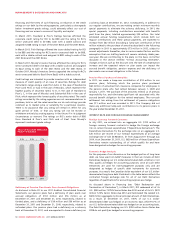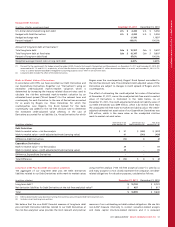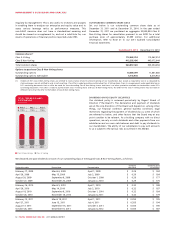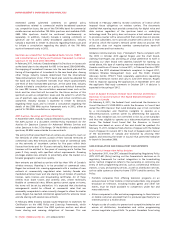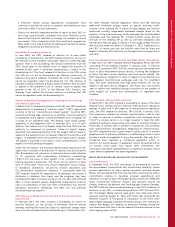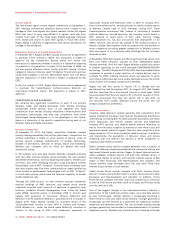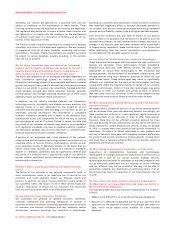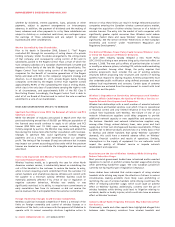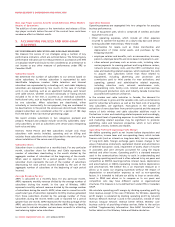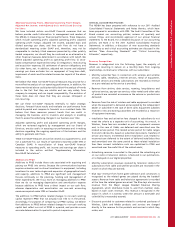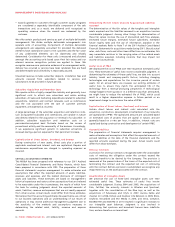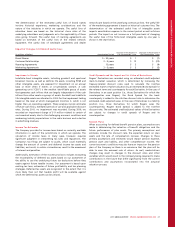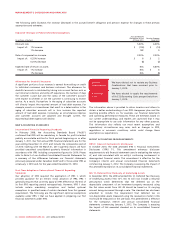Rogers 2011 Annual Report Download - page 62
Download and view the complete annual report
Please find page 62 of the 2011 Rogers annual report below. You can navigate through the pages in the report by either clicking on the pages listed below, or by using the keyword search tool below to find specific information within the annual report.MANAGEMENT’S DISCUSSION AND ANALYSIS
Distant Signals
The new distant signal consent regime commenced on September 1,
2011 whereby conventional television stations must consent to the
carriage of their local signals into distant markets. Under this regime
BDUs that want to carry time-shifted U.S. signals, must get prior
consent from each of the three large English-language networks
(CTV, Global and Citytv) to carry their signals in those time zones.
Rogers Media is currently in negotiations with various distributors for
carriage of distant signals.
Regulatory Approval of Recent Acquisitions
In December 2011, Rogers and Bell Canada announced an agreement
to purchase a 75% interest in MLSE. This transaction is subject to
approval by the Competition Bureau which will review the
transaction to determine whether it results in a substantial lessening
or prevention of competition. As part of this purchase of MLSE, we
will also acquire effective control, jointly with Bell Canada, of three
Category 2 television licences, Leafs TV, Raptors TV and Goltv and two
unlaunched Category 2 services, Mainstream Sports and Live Music
Channel. Acquisition of these services is subject to approval by the
CRTC.
In the first quarter of 2012, Rogers Media announced an agreement
to purchase the Saskatchewan Communications Network, an
over-the-air broadcast station. The acquisition is subject to CRTC
approval.
COMPETITION IN OUR BUSINESSES
We currently face significant competition in each of our primary
Wireless, Cable and Media businesses from entities providing
substantially similar services. Each of our segments also faces
competition from entities utilizing alternative communications and
transmission technologies and may face competition from other
technologies being developed or to be developed in the future.
Below is a discussion of the specific competition facing each of our
Wireless, Cable and Media businesses.
Wireless Competition
At December 31, 2011, the highly competitive Canadian wireless
industry had approximately 26.6 million subscribers. Competition for
wireless subscribers is based on price, quality of service, scope of
services, service coverage, sophistication of wireless technology,
breadth of distribution, selection of devices, brand and marketing.
Wireless also competes with its rivals for dealers and retail
distribution outlets.
In the wireless voice and data market, Wireless competes primarily
with two other national wireless service providers, the new entrants
described further below, and two large regional players, resellers such
as Primus, and other emerging providers using alternative wireless
technologies, such as WiFi “hotspots”. Potential users of wireless voice
and data systems may find their communications needs satisfied by
other current or development technologies, such as WiFi “hotspots”
or trunk radio systems, which have the technical capability to handle
mobile telephone calls.
Through the 2008 auction, six new entrants acquired substantial
regional holdings of AWS spectrum, and several much smaller
companies acquired small amounts of spectrum in generally rural
locations. Globalive Wireless Management Corp. under the brand
name WIND, launched service in December 2009 in Toronto and
Calgary with expansion to Vancouver, Ottawa, Edmonton and
Hamilton in 2010. Quebecor Media Inc. launched service in Quebec in
August 2010. Public Mobile Canada Inc. launched service in the
Toronto-Montreal corridor in early 2010 in Ontario and Quebec.
DAVE Wireless Inc., under the brand name Mobilicity, launched in
Toronto in the spring of 2010 with subsequent expansion in
Vancouver, Ottawa and Edmonton later in 2010. In January 2011,
Shaw Communications Inc. announced plans to launch wireless service
in Western Canada early in 2012. However, during 2011, Shaw
Communications announced that instead of launching a wireless
network based on licensed spectrum, the company would launch a
WiFi network in select parts of their cable territory. Bragg
Communications Inc. has also announced that deployment of an
HSPA+ network and activity has started in the several locations in
Atlantic Canada. New entrants could also partner with one another or
other competitors providing greater competition to Wireless in more
than one region or on a national scale, although this has not been
observed to date.
In November 2009, Bell Canada and TELUS each launched service over
their joint HSPA networks, overlaid on their CDMA/EVDO based
wireless networks. Until this time, Rogers Wireless was the only carrier
in Canada operating on the world standard GSM/GPRS/EDGE/HSPA
technology. The Bell Canada and TELUS HSPA launches enabled these
companies to provide a wider selection of wireless devices, and to
compete for HSPA roaming revenues which are expected to grow
over time as HSPA becomes more widely deployed around the world,
both of which will increase competition at Wireless.
Rogers was the first carrier to launch LTE in Canada and has
maintained the lead throughout 2011. By August 2011, Bell Canada
had also launched LTE in and around Toronto in small areas. TELUS
has announced that they will launch LTE in the first quarter of 2012.
MTS has announced that they will launch LTE in late 2012. As
LTE becomes more widely deployed around the world this will
increase competition at Wireless.
Cable Competition
Canadian cable television systems generally face competition from
several alternative Canadian multi-channel broadcasting distribution
undertakings (including Bell TV (previously Bell ExpressVu) and Shaw
Direct (previously Star Choice) satellite services and telephone
company IPTV services), and satellite master antenna television, as
well as from the direct reception by antenna of over-the-air local and
regional broadcast television signals. They also face competition from
illegal reception of U.S. direct broadcast satellite services. In addition
and importantly, the availability of television shows and movies
streaming over the Internet has become a direct competitor to
Canadian cable television systems.
Cable’s Internet access services compete generally with a number of
other ISPs offering competing residential and commercial dial-up and
high-speed Internet access services. Rogers Hi-Speed Internet services,
where available, compete directly with Bell’s DSL Internet service in
the Internet market in Ontario, with the DSL Internet services of Bell
Aliant in New Brunswick and Newfoundland and Labrador and
various resellers using wholesale telco DSL and cable Third Party
Internet Access services in local markets.
Cable’s Home Phone services compete with Bell’s wireline phone
service in Ontario and with Bell Aliant’s wireline phone service in New
Brunswick and Newfoundland and Labrador. In addition, Home
Phone service competes with ILEC local loop resellers (such as Primus)
as well as VoIP service providers (such as Vonage and Primus) riding
over the services of ISPs.
One of the biggest changes in the telecommunications industry is
substitution of the traditional wireline video, voice and data services
by new technologies. Internet delivery is increasingly becoming a
direct threat to voice and video service delivery. Younger generations
increasingly use the Internet as a substitute for traditional wireline
telephone and television services. The use of mobile phones among
younger generations has resulted in some abandonment of wireline
telephone service. Wireless-only households are increasing although
58 ROGERS COMMUNICATIONS INC. 2011 ANNUAL REPORT




